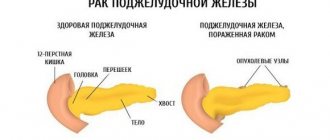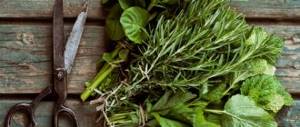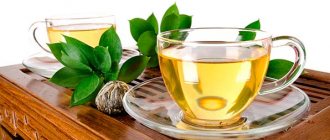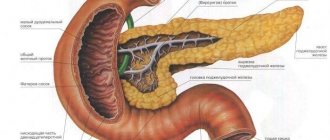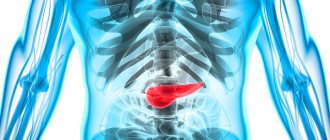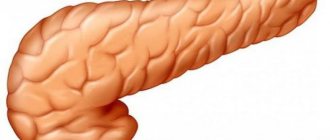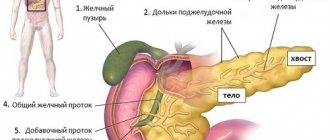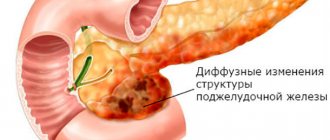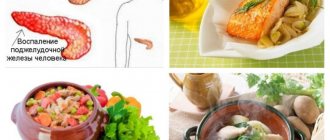Pancreas. A little anatomy
Nutrition for pancreatitis should be considered
The pancreas is located behind the stomach, adjacent to the duodenum. The weight of the organ is from 70 to 80 g, length from 14 to 22 cm. Functions of the organ:
- The production of enzymes that ensure food digestion processes - trypsin, pancreatic amylase.
- The pancreas works as an organ of the endocrine system - it produces insulin and glucagon. The former lowers blood sugar levels, the latter increases.
- Any organ injuries are considered severe pathologies that are hardly compatible with life. Even diagnostic or therapeutic punctures should be carried out with extreme caution.
This video will tell you how to care for a vital organ:
Pathologies of the pancreas
The main diseases of the pancreas diagnosed by doctors:
- Pancreatitis in acute and chronic form.
- Oncopathology of the organ.
- Cystic fibrosis is a hereditary disease that affects the exocrine glands.
- Diabetes.
- Pseudocystic processes.
All these pathologies require close attention of the doctor and the patient and lifelong treatment. The main symptoms of problems with the pancreas:
- diffuse, girdle pain under the ribs;
- constipation for several days;
- vomiting with traces of bile;
- painful nausea;
- yellowing of the sclera, nails, skin - obstructive jaundice;
- fever, general intoxication;
- pain accompanied by the appearance of bluish spots on the skin of the abdomen.
If such symptoms appear, you should immediately contact a medical institution.
Antacids (elimination of secondary symptoms)
Often with pancreatic disease, the patient has stomach problems when it begins to produce large amounts of hydrochloric acid. To neutralize it, a special group of drugs is used - antacids. They are designed to cope with exocrine insufficiency.
The following remedies will help reduce acidity and reduce the destruction of enzymes:
- Maalox
- Almagel
- Phosphalugel
Often patients with pancreatitis suffer from:
- Dysbacteriosis and diarrhea, Hilak Forte and Smecta can cope with these problems.
- Trimedat will help prevent intestinal motility disorders.
- For general intoxication – Enterosgel and activated carbon.
Nausea and vomiting. If the patient is plagued by nausea accompanied by vomiting, then this condition can be overcome with the help of Cerucal and Duspatalin.
Traditional and home treatment
Useful article? Share the link on VKontakte
“Proper food” as one of the aspects of treatment
Treatment of pancreatic pathologies is lengthy and may take more than 1 month. Requires attention and scrupulousness. Traditional drug treatment can be combined with home treatments. When you can’t treat the pancreas yourself:
- acute process accompanied by pain;
- in children;
- in pregnant and lactating women.
Traditional treatment is carried out either in a hospital or at home. This depends on the severity of the process, the patient’s age and concomitant diseases. What the doctor prescribes:
- Antacids are drugs that lower the pH of gastric juice.
- Enzymes are natural substances produced by the pancreas. This reduces the load on the diseased organ, which gives it the opportunity to recover.
- Painkillers, antispasmodics for pain relief.
- Antibiotics to suppress pathogenic microflora and the inflammatory process.
- The diet for acute pancreatitis is a complete lack of food. After stopping the acute process, it is recommended to adhere to table No. 5.
Traditional medicine measures can be carried out at home, but only after acute symptoms have been relieved, the patient’s condition has normalized, or the disease is mild.
How to relieve inflammation
How to calm the pancreas at home? First of all, you need to give up foods that stimulate the production of gastric juice and increase painful symptoms. Everything fried, fatty and smoked should be excluded from the diet. Spicy seasonings and sauces are also prohibited. To calm the pain and restore normal functioning of the organ, it is important to eliminate all concentrates and acids. The menu during the period of exacerbation of the inflammatory process should consist of a limited number of products.
Boiled potatoes are allowed. You can additionally include zucchini stew in your diet. However, it is not recommended to eat eggplants, tomatoes and mushrooms during an exacerbation period. Potato juice is very useful and will help get rid of inflammation. It can be used for treatment only in chronic cases of the inflammatory process, that is, when there are no painful symptoms.
To quickly get rid of acute manifestations of the inflammatory process, you must follow a diet that includes jelly, crackers, pureed soups without meat broth, steamed omelettes and cottage cheese. Alcohol and carbonated drinks are strictly prohibited during treatment.
If this rule is not followed, the inflammatory process will provoke necrosis of the gland tissue.
Digestion aids should be taken with meals. Therapy with enzyme group drugs plays a decisive role. For this purpose, Mezim, Pancreatin, Panzinorm and Creon are used. This line of products helps to compensate for the deficiency of pancreatic enzymes.
Important information: What medications to take when the pancreas hurts and how to relieve pain
People suffering from acute pancreatitis should be treated in a gastroenterology hospital. If the pancreas is inflamed, then painkillers from the group of analgesics and antispasmodics are administered intravenously. To relieve acute symptoms, Metronidazole is additionally used, which has an anti-inflammatory effect.
During treatment, intravenous infusions of saline are used, since when the gland is inflamed, the body is often dehydrated. It is advisable to drink as much fluid as possible. It is best to drink regular filtered water. If tablets at home do not help, then urgent hospitalization is required.
Phytotherapy
Herbal medicine gives good results
Herbal medicine is an auxiliary method of treatment. Herbs have a number of contraindications and side effects. Therefore, it is prohibited to prescribe treatment yourself. In an acute process, herbal medicine can be used only after the attack has stopped.
For chronic pancreatitis, herbal infusions help reduce dependence on medications and delay exacerbation. Contraindications for taking herbal medicine:
- acute stage of the disease;
- individual intolerance to the components of the collection;
- allergy to herbs that developed during treatment;
- as monotherapy for life-threatening conditions.
It is advisable to buy herbs from a pharmacy chain, since in this case you will be sure that the raw materials were not collected near roads or in an environmentally unfavorable area.
Important! Decoctions of medicinal herbs are taken for no more than 14 days. Then you should either take a break or use other herbal remedies.
Recipe No. 1
You will need St. John's wort, mint and motherwort in equal proportions - 30 g of dry raw materials each. Pour 0.5 liters of boiling water. Let it brew for 1 hour and strain. Take half a glass 3 times a day.
Recipe No. 2
For chronic processes, the following collection is recommended - yarrow, calendula flowers, peppermint. Herbs are taken in a ratio of 1:1.5:2. The decoction is prepared in the classical way: 5 g of the mixture per 250 ml of liquid. Let it brew and take 2 times a day.
Recipe No. 3 - so-called Tibetan tea
Kefir is considered a healthy product
The herbs required for the medicinal decoction also grow here. These are St. John's wort, chamomile, birch buds and immortelle flowers. All of them have anti-inflammatory properties, relieve spasms, and improve bile production.
Take herbs in equal parts. For 0.5 liters of water you will need 30 g of plant material. Pour boiling water over and let it brew. Drink like tea. You can sweeten it with honey or take it yourself with pleasure.
Recipe No. 4
The following herbs will be required: dill seeds, mint, hawthorn, chamomile in a ratio of 3:3:2:2:1. The decoction is brewed at the rate of 5 g of mixture per glass of boiling water. Leave until completely cool. The infusion is taken 0.5 cups 3 times a day.
Recipe No. 5
You will need cumin, nettle, calamus, valerian and yarrow in a ratio of 3:3:3:1:1. Brew with boiling water and leave to simmer in a water bath for half an hour. Remove and wrap. Let it brew for another 30 minutes. Take 0.5 cups 3 times a day.
Recipe No. 6 recommended for organ cancer
Steam one glass of oats in 250 ml of boiling water. Let it brew for 12 hours. Strain and drink the infusion. Take every day. In addition, it is recommended to cook oatmeal jelly. Take pureed and warm.
Recipe No. 7 – celandine for pancreatic cancer pathologies
To obtain the infusion you will need 5 g of celandine herb. Steam the plant material in 1 cup of boiling water. Wrap up and leave for 1.5 hours. Take 60 ml - 2 tbsp. spoons - before meals 3 times a day.
Pain relief for pancreatitis: use of medications
How to relieve pain from an attack of pancreatitis? To do this, they resort to the use of painkillers, which help to quickly and effectively forget about the pain.
- Use painkillers for the pancreas. These are drugs such as Baralgin and Paracetamol. With their help you can relieve pain within 30 minutes.
- Taking antispasmodic drugs. These medications include: No-Shpa, Papaverine and others. With their help, you can relieve spasms not only in the pancreas, but also in the bile ducts.
- After the acute pain disappears, it is recommended to take enzyme preparations together with food. These are drugs such as Creon, Mezim and Festal. With their help, it is possible to relieve the work of the pancreas.
- Analgesics for the pancreas at home: Aspirin, Diclofenac, Analgin and others.
We also recommend viewing: How can you replace the pancreas?
Most patients resort to traditional recipes to relieve pain during attacks of pancreatitis. Such folk recipes produce a positive effect, which is why their use is so popular. These recipes include:
- Half an hour before meals you need to drink 0.5 cups of potato juice. The course of treatment is 7 days. Potato juice from raw potatoes can be diluted with carrot juice.
- Infuse plantain, hawthorn and mint, then drink the decoction three times a day before meals.
- Prepare an oat decoction, which is also drunk half an hour before meals.
- Infuse a decoction of motherwort, St. John's wort and immortelle for half an hour. Drink 0.5 glasses every day.
- Brew herbs such as burdock root, blueberries, dill seeds, St. John's wort and motherwort. The resulting decoction should be drunk 3 times a day before meals.
Every patient should understand the risks of treating pancreatitis at home. As mentioned above, if the disease is not treated for 5-6 months, then the likelihood of the disease becoming chronic increases. To exclude the occurrence of serious consequences, it is necessary to provide assistance to the patient at the first signs of an attack, and then call an ambulance. After delivering the patient to the hospital, a course of treatment is required under the supervision of a doctor.
This is interesting! When treating pancreatitis, you must be careful when using traditional recipes. If folk recipes are used incorrectly, the development of serious complications cannot be ruled out.
How to eat with pancreatic diseases
Pancreatitis can also occur as a result of taking certain medications.
Treatment of diseases of this organ is always accompanied by adherence to a diet. Most often, this is not a strict restriction, but simply adherence to the principles of rational nutrition. Recommendations vary slightly depending on the pathology.
Acute pancreatitis
The first and second days from the onset of inflammation - absolute refusal of food. You are only allowed to drink water or rosehip decoction, but not more than 1.5 liters per day. Third day – non-calorie dishes are introduced. The total energy value of food is 900 kcal per day. Salt is completely excluded. The diet contains only carbohydrates.
On day 5, protein dishes and dairy products are introduced. Over the course of several days, the diet expands. No salt is used. After the symptoms of an acute condition are relieved, vegetable soups, lactic acid products, cottage cheese, fruits and vegetables are allowed. Meat and fish are allowed.
Pickles and smoked meats, sweet pastries, hot seasonings and spices are prohibited. Alcohol is strictly prohibited. This diet will have to be followed for 12 months after the acute episode. The diet is then adjusted depending on the patient’s condition and the doctor’s recommendations.
Chronic pancreatitis
A nutritionist will definitely prescribe a diet!
A chronic process develops without proper treatment of the acute stage of the disease or if the patient has other pathologies of the liver, stomach, or allergic reactions.
During the day there should be 6 meals in small portions. Low-fat varieties of meat, poultry, fish, and cottage cheese are allowed. Milk only when warm and no more than 0.5 cups per day.
It is advisable to replace it with fermented milk products. Vegetables and fruits should be present in the diet, and salt should be limited as much as possible. Alcohol is prohibited.
Diabetes
In the case of this disease of the pancreas, a diet similar to the diet for pancreatitis is indicated.
Organ oncology
The main rule is no fats of any kind. Remove pans from the kitchen. The food is only warm, without spices or other odorous substances or additives. The break between meals is no more than 2.5 hours.
Some conclusions
The pancreas is an inconspicuous but vital organ. Failure of the gland is fatal. It's easier to prevent illness. Follow the principles of a healthy diet, limit alcohol and tobacco.
Do not self-medicate. Check all home recipes with your doctor. In case of exacerbation, strictly adhere to the diet and take prescribed medications.
Improper functioning of the pancreas causes considerable discomfort to a person. In addition, the disease threatens serious complications if measures are not taken in time. Therefore, the question of how to treat pancreatitis plagues everyone who is faced with this problem. How the pancreas is treated with drugs and alternative methods, you will learn from the presented review.
Complications
In addition to side effects, the patient may experience complications. This, in turn, depends on incorrectly prescribed treatment and non-compliance with the dosage.
Complications:
- Pylephlebitis.
- Abdominal abscess.
- Parapancreatitis.
- Purulent complications.
- Arrosive bleeding.
So, we can conclude that there are many medications, the most effective ones are given.
Every patient should understand that the same medicine may not be suitable for two different people. Also read: Chronic pancreatitis - treatment with folk remedies
Therefore, you should not self-medicate; it is better to consult a doctor. Indeed, with untimely and illiterate treatment, serious complications can arise.
What is pancreatitis and how to treat it
Poor nutrition is the main cause of symptoms of pancreatitis. Inflammation occurs due to frequent overeating, eating spicy and too fatty foods. If you frequently follow strict diets, the risk of developing the disease is also high. Due to a lack of proteins and fats, the body does not function properly. At the same time, drinking alcoholic beverages significantly increases a person’s chances of developing pancreatitis.
Women are diagnosed as a secondary disease as a result of:
- Gallbladder problems.
- Gastric ulcer.
- Cholangitis (improper functioning of the biliary tract).
- Gallstones.
- Abuse of cigarettes and alcohol.
How to treat the pancreas depends on the degree of the disease. The disease can be chronic or acute. Lack of treatment inevitably leads to dire consequences. A person can get pancreatic necrosis, cholecystopancreatitis, diabetes or pancreatic necrosis. All complications subsequently develop into other diagnoses, including cancer.
Spicy
The acute form of the disease is sometimes difficult to diagnose. The patient feels discomfort in the area of the shoulder blades, heart, shoulder, and left side of the body. At the same time, the human condition is dynamically progressing for the worse. In such cases, treatment of pancreatitis in a hospital is required, preferably as soon as possible. It is often necessary to resort to surgery on the pancreas.
Chronic
There is another form of the disease - chronic. With it, the pancreas is constantly inflamed and does not work properly. Food is poorly absorbed into the intestines, resulting in the development of a huge number of pathogenic bacteria. Symptoms of exacerbation of the disease in this case:
- diarrhea (can be repeated up to 7 times a day; a person rapidly loses weight if exacerbations occur frequently);
- belching;
- vomit;
- bloating.
Treatment of chronic pancreatitis includes proper nutrition, supportive care, and regular ultrasound examinations. This will identify changes for the worse at the initial stage and prevent the development of complications. In severe forms, in addition to drug treatment, the patient is prescribed fasting for 3-5 days, and sometimes enteral nutrition.
Treatment of the pancreas with folk remedies
Helping the body treat pancreatitis at home is an equally effective method. Treatment of the disease with folk remedies brings good results only if carried out correctly. Many products in the garden and in the refrigerator can help a person if used correctly. A strict diet or even fasting, recipes from grandmothers and mothers, are no less effective treatment for inflammation of the pancreas than medications.
Herbs
Herbal medicine is one of the popular ways to eliminate many diseases, which Russians have been using for a long time. It is effective for prevention and will help heal the pancreas. How to treat pancreatitis with herbs? Take decoctions and infusions regularly. For example, chamomile, immortelle, celandine and wormwood are infused and taken before meals, half a glass.
Recipe for making the product:
- Dry herbs and flowers take 1 tbsp. spoons of each type.
- Pour boiling water (300 ml).
- Cool and drink 6 times a day.
Oats
One of the simple and effective folk ways to treat pancreatitis at home is to include oats in your diet. This cereal is known in medicine for its cleansing properties and has been used for many years to remove waste and toxins from the body. It is useful to consume oatmeal or milk not only for pancreatitis, but also for restoring the liver. To prepare the product at home, cook unrefined oats (whole grain cereal).
Honey
The bee product is very beneficial for the body. It is an antiseptic, anti-inflammatory, protective agent. How to treat pancreatitis with honey? Mix 100 g of honey with black radish juice (250 ml). The resulting product is used for one month every day, 1 tbsp. spoon before meals. This will help normalize metabolic processes, regenerate damaged cells, and renew the blood.
Diet
For those who would like to learn how to treat pancreatitis with diet, it is important to learn the rule: “Less harmful, more healthy foods.” You should avoid eating for the first couple of days. At this time, the gastrointestinal tract should be completely unloaded, and the pancreas will stop producing excess enzyme. At the first stage of treatment, you are allowed to take herbal decoctions, still water, and rose hips. Next, about two weeks of separate meals are prescribed and the diet is gradually increased.
Treatment of pancreatitis with medications
Treatment of the pancreas in a child or adult is based on a combination of several methods. The scheme is as follows:
- Hunger.
- Intravenous administration of vitamins.
- Antibiotics.
- If necessary, antispasmodics, antihistamines, anticholinergics.
Tablets
After diagnosis, doctors prescribe medications to the patient individually:
- If the patient has a secondary development of cholangitis, then antibiotics are prescribed: Cefspan, Doxycycline, Ampiox.
- The following antispasmodic drugs are used for pancreatitis: “No-spa”, “Gastrotsepin”, “Platifillin”, “Atropine”.
- If the disease is accompanied by swelling, additional diuretics are prescribed.
- In case of violations of the external secretory function of the pancreas, enzyme preparations are prescribed: “Vigeratin”, “Pancreatin”, “Nigedase”.
- Painkillers may be prescribed: Baralgin, Pentazocine, Ibuprofen.
Drugs for the treatment of pancreas
In addition to tablets, injection solutions, suspensions, and microspheres are used to treat pancreatitis:
- The enzyme preparation "Creon" does not contain bile acids. The composition includes natural components that promote the breakdown of fats and proteins.
- Gentamicin is an antibiotic from the aminoglycoside class. It is used intramuscularly to prevent complications.
- "Cerucal" is prescribed intramuscularly to prevent vomiting.
Find out in more detail how the pancreas is treated with medications.
Homeopathy
Treatment of pancreatitis with homeopathy is prescribed to patients in conjunction with a strict diet, sometimes with the prescription of insulin (enzymes or hormones). The procedure is performed in a hospital setting. This is a conservative therapeutic method that sets strict boundaries for the patient. Treatment allows you to achieve stable remission of chronic pancreatitis and avoid complications. Sometimes, subject to the regimen and the doctor’s requirements, a person is completely cured.
general information
Various tablets are used to treat pancreatitis.
For this disease, doctors prescribe the following medications:
- Sedatives.
- Choleretic.
- A course of hormonal therapy is prescribed on an individual basis.
- For moderate and severe severity, medications with calcium are prescribed, as well as enveloping drugs for pancreatitis.
In addition, in case of inflammation of the pancreas, vitamins from group B, A, D, K and E are mandatory. They are necessary to support the body throughout the entire therapeutic course.
What is prescribed for pancreatitis?
Now we will look at the main drugs used to treat the disease. So, first of all in case of such a problem, doctors prescribe antisecretory drugs, for example: Omeprazole or Ranitidine.
The two drugs have a single function - the active components of the products quickly act on the receptors. Thus, hydrochloric acid is suppressed, which in turn helps to slow down the work of the pancreas.
Important! The drugs have a wide list of contraindications and side effects; you should not self-medicate.
As for the side effects of Omeprazole and Ranitidine, the most common are headache, nausea or an allergic reaction. Note that Ranitidine is better tolerated for mild pancreatitis.
The second stage of therapy is the use of painkillers that help relieve spasms and attacks.
Prescribed:
- But-shpu.
- Phosphalugel.
- Gaviscon.
Also read: Treatment of pancreatitis with medications - which ones are more effective
We would like to draw your attention to Gaviscon, it is an antacid. The drug is available in the form of chewable tablets, but in an acidic environment (stomach) the medicine turns into an alginate gel. In this case, the pH is reduced to zero.
Due to this, the active components of Gaviscon form a protective layer and reduce the risk of GER (gastroesophageal reflux).
If the patient has an inflammatory process in the bile duct (as a rule, this happens in a chronic course), then it is necessary to take antibiotics.
The most common antibiotics for pancreatitis are Cerufoxime (used in complex therapy) and Doxycycline, which is available in both tablets and ampoules. In case of severe disease, Doxycycline tablets will not be prescribed, but intramuscular injections will be given.
They can also write:
- Vancocin: not only belongs to the group of antibiotics, but is also a glycopeptide.
- Abaktal
- Ceftriaxone.
Third stage of treatment. Almost all patients with pancreatitis experience swelling. In this case, the patient needs to take anti-enzyme medications.
So, what are the best pills to treat pancreatitis? The most effective are Creon, Mezim, and Pancitrate. All have a wide spectrum of action, so read the instructions carefully before use.
What other tablets are prescribed for the treatment of pancreatitis?
When the pancreas is inflamed, every doctor strives to normalize digestion as quickly as possible. Pancreatin will help you with this.
The composition is truly amazing, because it affects not only fats, but also proteins and carbohydrates. But the instructions say that it cannot be used in acute cases, so before use you need to consult a doctor, because in this case you will already be prescribed an analogue.
Note that this remedy also helps restore pancreatic enzymes. If Pancreatin does not bring a positive result, then in chronic cases Festal or Famotidine is prescribed.
Chief gastroenterologist of the Russian Federation: “PANCREATITIS does not go away?! A simple treatment method has already healed hundreds of patients at home! To cure the pancreas forever you need...” Read more »
Is it possible to cure pancreatitis completely?
Anyone who has encountered a problem asks the question: “Can chronic pancreatitis be completely cured?” There is an opinion that it is impossible to get rid of inflammation of the pancreas forever. This stops people from further treatment. Pancreatitis can be cured by those who do not give up trying and achieve success by getting rid of the disease.
Treatment of chronic pancreatitis in the acute stage is extended until complete recovery. Otherwise, signs of the disease will appear again. Inflammation of the pancreas is detrimental to the body. To prevent serious complications, it is important to start therapy in the early stages. Starting with several days of fasting, continuing with a strict diet and medications, sometimes it is possible to overcome the disease. The success of the procedure depends on the patient, his willpower and responsibility. The doctor helps relieve acute pain and gives instructions. Further recovery is in the hands of the patient.
If a person values his health, he will follow the following recommendations for the treatment of pancreatitis:
- To refuse from bad habits.
- Eat properly.
- Avoid stress.
Reviews about the treatment
Lyubov, 47 years old: I’ve been living with pancreatitis for seven years now. I regularly take pancreatin and omeprozole to improve the functioning of the digestive tract. Thanks to this, the pancreas is not particularly bothered. I really like drugs that are inexpensive and effective.
Inga, 27 years old: My mother has had chronic pancreatitis for several years. Treatment for exacerbations in the hospital is prescribed, and at home she drinks cabbage juice. It contains enzymes that help the pancreas function.
Ivan, 43 years old: The doctor recommended a homeopathic course for pancreatitis. The problem with the pancreas became less of a concern, but a rash appeared. Due to complications, I was dissatisfied with the treatment.
Despite the small size of the organ relative to others in the human body, the pancreas plays an extremely important role. It is involved in the process of secreting enzymes necessary for the proper functioning of the intestines. If the organ begins to function poorly, stopping or reducing insulin production, the risk of developing diabetes increases. The disease remains with a person forever, bringing many problems. To avoid consequences, it is worth knowing how to treat the pancreas at home. The most effective remedies are described below.
Antacids for pancreatitis
Below are a few drugs that really give good results. But remember, you can’t take them yourself; each one comes with instructions; after studying it, you will understand that the list of contraindications and side effects is quite long, be careful.
Also read: Treatment of pancreatitis with folk remedies - the most effective
Prescribed:
- Almagel.
- Rennie.
Such tablets for pancreatitis are prescribed if the disease is isolated. What does it mean? This means that drugs are prescribed for mild cases, since the effectiveness of the drugs is short-term.
On a note! If you have an inflamed pancreas, as well as a history of gastritis or an ulcer, then it is better to use Rennie in treatment. Patients with renal failure are prescribed analogues.
To the question: is it possible to cure a stomach or duodenal ulcer at home, a gastroenterologist, head of the gastroenterology department, Mikhail Vasilievich Arkhipov, answers.
We wrote above that for such a disease, choleretic drugs are prescribed. The most effective are Allohol and Cholestil.
Allohol has a good composition, it contains the following components: activated carbon, garlic bulb, as well as bile and nettle. The medicine enhances the process of bile formation, therefore helping the body cope with the problem faster.
The instructions say that Allochol cannot be used in treatment if the patient has an individual intolerance to the composition (read the additional list of contraindications). Note that Allochol is used only for chronic disease.
They wrote on the forums that Cholestil was used for inflammation of the pancreas. But, it does not apply to tablets, these are capsules that are considered a dietary supplement. The cost of the supplement varies up to 100 rubles; as a rule, it is prescribed in complex therapy with one of the above-described remedies.
What is inflammation of the pancreas
The disease is called pancreatitis. It develops in the form of inflammation in any part of the pancreas or encircles the entire organ. Pancreatitis can be acute or chronic. During the pathological process, tissue breakdown (necrosis) of the pancreas occurs. In this case, the person feels constant aching or cutting pain. Over time, the syndrome becomes stronger, sometimes leading to a state of shock. Painful sensations radiate to the left or right hypochondrium. Other symptoms:
- diarrhea;
- vomiting mixed with bile;
- dry mouth;
- belching, increased gas formation;
- temperature increase;
- decreased blood pressure;
- sweating;
- dyspnea;
- pale skin;
- pronounced coating on the tongue;
- weight loss.
Unlike the chronic form of pancreatitis, the acute form is life-threatening. If a person has developed this disease, he feels a sharp girdle pain in the upper abdomen. He vomits often. Many people experience severe weakness and dizziness due to a drop in blood pressure. The patient notices that he is defecating food that is not completely digested. Acute inflammation of the pancreas is characterized by repeated attacks accompanied by severe pain.
The doctor diagnoses the disease using ultrasound. The diagnosis is confirmed if there are diffuse changes in the pancreas. Recovery, as a rule, comes spontaneously. Pancreatitis does not cause irreversible damage to the organ, except in cases of constant alcohol abuse by the patient. In this case, tissue destruction occurs continuously. What stimulates the development of the disease:
- frequent consumption of fatty foods;
- alcoholism;
- inflammation of the stomach and other digestive organs;
- cholecystitis (as a result, cholecystopancreatitis may develop);
- if a person takes any medications for a long time;
- hormonal imbalance.
What contributes to the development of pancreatitis
The pancreas suffers when exposed to the following factors:
- Frequent overeating. If a person is full, then there is no need to overeat, as this negatively affects not only the pancreas, but also the digestive system as a whole.
- With frequent consumption of fried, spicy and fatty foods.
- If a hormonal disorder occurs in the body.
- When using medications.
- With the development of inflammatory diseases.
- If a person has helminths.
- With alcohol abuse.
These are just the main reasons for the development of pancreatitis, in the presence of which the pancreas is subjected to serious tests. You should eliminate the impact of all of the above reasons as quickly as possible in order to protect yourself from the development of dangerous diseases.
We also recommend viewing: Symptoms and treatment of liver and pancreas disease
Treatment of pancreatitis at home
It is strictly forbidden to treat acute pancreatitis at home - this can be fatal. If you suspect this disease, you should immediately call an ambulance. While waiting for the doctor, you should not take painkillers or apply a heating pad to the area where pain is felt. Treatment order:
- to relieve severe pain, you can take an antispasmodic and apply cold to the stomach;
- the first stage of therapy takes place in a hospital setting;
- upon discharge, the doctor will tell you how to further treat pancreatitis.
In case of chronic pancreatitis, the disease can be treated at home, but only after a complete examination (including laboratory tests of blood/stool tests) and confirmation of the diagnosis. Only a specialist will be able to determine the cause of the development of pancreatitis and recommend rational treatment methods from traditional and traditional medicine. To be cured, you must strictly follow all the doctor’s instructions.
Therapy must necessarily include a diet and giving up all bad habits, be it smoking or drinking alcoholic beverages. In addition, treatment of the pancreas is not carried out without taking a number of drugs that have an analgesic effect and help normalize the functioning of the digestive system. During the period of exacerbation of the disease, a person is advised to rest with predominantly bed rest.
Drug treatment of the pancreas
Recovery with absolute restoration of the organ with pancreatitis is impossible to achieve. The main direction of treatment is to prevent further destruction of the pancreatic structure. It is prohibited to start taking medications on your own (with the exception of mild antispasmodics), since this can provoke irreversible changes in human organs and systems.
An exceptionally experienced doctor can select therapeutic agents for the treatment of pancreatitis. Drug treatment of the disease consists of eliminating a number of problems:
- Pain relief. An exacerbation of the disease is characterized by a high degree of pain. They are treated with drugs such as Papaverine, No-shpa, Atropine, Novocaine, etc. It is forbidden to take Nise, Aspirin and other NSAIDs. They thin the blood, irritate the digestive mucosa and can stimulate internal bleeding.
- Decreased pancreatic secretion. They use Omeprazole, Contrikal, Allochol.
- Cleansing and unloading of the pancreas. To do this, take enzymes and medications based on plant components that stimulate the digestive process. These include: “Befungin”, “Festal”, “Alma-gel”, “Creon”, “Digestal”, etc.
- Antibacterial action. The doctor prescribes mild antibiotics such as Ampicillin and Gentamicin to prevent the development of infections.
- Replacement therapy. To restore water and electrolyte balance, physiological and saline solutions are prescribed.
Pancreatic diseases that can be treated
When prescribing tablets for the liver and pancreas (PG), the doctor takes into account their pharmaceutical effects in order to achieve the therapeutic goal faster and more effectively.
Namely, drugs for inflammation of the liver and pancreas are prescribed:
- Baralgin, No-shpa, Spazgan, Papaverine - for an analgesic effect: reducing acute pain and spasms;
- Enzyme forte, Creon, Pancreatin, Festal - to compensate for enzyme deficiency: facilitating the functioning of the digestive system and eliminating the inflammatory process;
- Almagel, Maalox, Phosphalugel - to neutralize the aggression of acidic secretions: to prevent further destruction of the tissues of the digestive organs;
- Ampicillin, Doxycycline, Tobramycin, Cefspan, Cephobid - to inhibit pathogenic bacteria: reduce inflammation and swelling.
In case of exacerbation, call an ambulance and inject No-shpu into the muscle to eliminate spasms in the pancreatic ducts. In this case, the patient should sit down, pressing his legs to his stomach and tilting the front part of his body slightly forward to reduce pain and muffle attacks of nausea. A cold compress is applied to the epigastric area and left for 10-15 minutes.
Means to maintain pancreatic function
Chronic inflammation is eliminated and the functioning of the pancreas is supported by enzyme preparations: Almagel A, Creon 1000, Mezim, Maolox. Restore digestive functions and normalize intestinal microflora by administering Lacton, Linex or Lacidofil with or after food.
If we consider medications for restoring the liver and pancreas, the list of painkillers and enzymatic agents also includes: Pancreatin, Panzinorm, Digestal, Lycreaz, Creon, Festal and Enzistal. Medications that normalize the concentration of enzymes during exacerbation of the pancreas: Digestal, Lycreaz, Creon and Festal. They restore the functioning of the pancreas and digestion, and prevent subsequent relapse.
From this list, bile contains the following drugs: Festal, Ferestal and Enzym forte. These drugs are used to treat pancreatitis, but they are prohibited for stomach and duodenal ulcers, gastritis and cholelithiasis.
Mezim and Pancreatin contain enzymes: amylase, protease and lipase, so they cannot be taken for a long time so as not to cause pancreatic dysfunction. Heptal and Allahol increase the secretion of liver cells, so they are often prescribed for pancreatitis.
Pain syndrome during inflammation of the pancreas is eliminated with the following pharmaceuticals: Gastrocepin, Platyfillin, Atropine, Baralgin. If the patient cannot tolerate the pain, then use narcotic drugs - Tramal or Promedol.
Analgesic for pain relief due to inflammation of the pancreas
To get rid of pancreatic diarrhea, the following medications are prescribed for diseases of the pancreas and liver:
- Bactisubtil - 1 capsule orally 3-6 times a day, up to 10 capsules - for relief of severe diarrhea, contraindicated - in case of hypersensitivity to the components of the drug;
- Regidron - 10 ml/kg after each attack of diarrhea. Contraindicated in arterial hypertension, diabetes mellitus, acute renal failure and chronic renal failure, excess potassium;
- Tannacomp - 1 tablet 4 times to eliminate diarrhea and 1 tablet - 2 times for prevention. Pregnant women should take with caution after consulting their doctor.
Diarrhea remedy
If bile is released during persistent vomiting, then treatment is carried out with a medicine for the liver and pancreas such as Metoclopramide, Metukal or Cerucal.
If intraductal pressure in the pancreas increases and the productivity of pancreatic juice increases, acute pain occurs in the upper part of the peritoneum, and the acid-base balance is disturbed.
At the same time, unnatural processes are activated in the stomach, to stop which antacids are prescribed: Acyloc, Getrocalm, Zantac, Omez. Patients take them for several days to get out of a critical condition.
Antacid for acid-base imbalance
Also, gastric problems occur with long-term treatment of pancreatitis, since excessive amounts of hydrochloric acid are produced. Tablets for the stomach and pancreas reduce acidity and improve the digestion process; the list includes: Almagel, Omez (Omeprazole), Maalox, Phosphalugel.
To quickly cleanse the body of toxins, activated carbon or Enterosgel is prescribed. For bacteriosis and inflammation of the pancreas, take Smecta, and for impaired intestinal motility - Trimedat.
Remedies for heartburn and improved digestion
Antienzyme (antisecretory) agents. During an exacerbation, the pancreatic parenchyma tends to swell, so its ducts narrow. And again, the outflow of pancreatic juice is disrupted, while the pancreas still synthesizes digestive enzymes. Their production can be blocked with antienzyme drugs: Nizatidine, Famotidine, Esomeprazole, Cimetidine.
Histamine H2 receptor blockers and proton pump inhibitors are used as antisecretory (antienzyme) and pain relievers. The most popular tablets for the treatment of the pancreas are: Gordox, Omeprazole, Esomeprazole, Nizatidine, Lansoprazole, Rabeprazole and Cimetidine.
Nonsteroidal anti-inflammatory drugs are prescribed to normalize temperature, reduce inflammation and pain. NSAIDs: Aspirin, Diclofenac, Ibuprofen can reduce the risk of general intoxication of the body
So, to relieve inflammation, heat and pain, treatment is carried out:
- Aspirin – 4 g/day. Contraindicated in case of cardiac, renal and liver failure, hemorrhagic diathesis, asthma, ulcers, in combination with Methotrexate;
- Diclofenac tablets - 50-150 mg/day in 2-3 doses. Cannot be used during pregnancy, lactation, hypersensitivity, destructive-inflammatory pathologies of the gastrointestinal tract, diseases of the hematopoietic system, ulcers;
- Ibuprofen – up to 6 tablets/day. Contraindicated in case of allergies to components, severe heart failure, renal-hepatic dysfunction, gastrointestinal bleeding and ulcers, in the 3rd trimester of pregnancy.
- If a bacterial infection is added to the inflammation of the pancreas, cholecystopancreatitis develops, then treatment is carried out with broad-spectrum antibiotics: Ampicillin, Bactrim, Kanamycin, Olethrin, Sigmamycin and probiotics to maintain beneficial microflora in the intestines.
Medicines for the treatment of the pancreas improve the release of pancreatic juice and relieve spasms in the pancreatic ducts: Bendazole, Bencyclane, Mebeverine or Platiphylline.
Since it is necessary to support the liver, and chronic pancreatitis is difficult and even impossible to cure, a medicine for the treatment of the pancreas and liver restores tissue, such as:
- herbal preparation Pancretinol with extracts of anise, elm, goldenseal, mint, chamomile and fennel. Dose – 1 tablet/day for a course of 30 days;
- Bifidumbacterin with sucrose, live bifidobacteria, skim milk, edible gelatin. Take 30 minutes before meals according to the dosage indicated on the package;
- Hilak Forte - for dyspeptic disorders and to improve overall well-being, restore beneficial microflora and normalize the acid-base balance. Dose – 50 drops – three times a day, the course is prescribed by the doctor individually.
Special medications are used to treat the pancreas. However, they are always selected taking into account not only the individual characteristics of the patient’s body, but also the type of disease that was diagnosed with him. And before voicing the names of the pills that are most often used to compensate for glandular insufficiency, it is necessary to consider what types of pancreatic diseases there are.
Among them, the most common are:
- acute and chronic pancreatitis;
- diabetes;
- cystic fibrosis;
- pancreolithiasis;
- pancreatic tumor;
- pancreatic cancer.
Chronic pancreatitis
In all these cases, different treatment of the pancreas with tablets is carried out. But they do not always give positive results. Unfortunately, in the presence of diseases such as pancreolithiasis, cancer and pancreatic tumors, drugs provide only a temporary effect. To cure these diseases, surgery is required.
Most diseases of this organ cannot be treated with medication. Most often, pancreatic pills are prescribed only as an auxiliary therapy, which can reduce the manifestations of the disease and prevent its further progression.
And if we talk about what signs of pancreatic diseases have, it should be noted that when this organ malfunctions, digestion is the first thing to suffer. This is manifested by the occurrence of:
- heartburn;
- belching, after which a bitter taste is felt in the mouth;
- feeling of heaviness in the stomach;
- stool disorders;
- nausea;
- increased frequency of urination;
- constant thirst;
- aversion to fatty and fried foods;
- weaknesses.
Location of the pancreas
It should also be noted that pancreatitis is often accompanied by acute girdling pain in the upper abdomen, which literally constrains the patient, fever and vomiting. As a rule, such symptoms occur during exacerbation of the disease.
Important! If there is a sudden exacerbation of pancreatitis, you should not look for information on the Internet about what to do for pain in the pancreas. You should immediately call a team of doctors to your home! If the patient does not receive timely medical care, this can lead to serious consequences, including necrosis and the development of an abscess.
How to treat the pancreas with diet
The primary measure for exacerbation of chronic pancreatitis is diet. If a person has developed an acute form of the disease, you should immediately call a doctor, and after discharge from the hospital, adhere to the rules of dietary nutrition. For the first 3 days you should fast; you are only allowed to drink plenty of non-carbonated mineral water (preferably warm). After fasting, a patient with pancreatic inflammation is prohibited from eating a number of foods.
General principles of nutrition
In case of inflammation of the organ, it is recommended to switch to 6 meals a day with small portions. Products can be steamed or boiled in water, after which they must be pureed to a puree consistency. You should eat food only warm, avoiding cold and hot food. The diet for pancreatitis includes lean soups with cereals, chicken soufflé. Fresh low-fat fermented milk products are recommended. This nutritional system is low in calories and contains a minimal amount of fat.
Authorized Products
- Porridge cooked in water.
- Lean meat/fish.
- Vegetable broth soup with cereals.
- Sunflower/olive oil.
- Low-fat cottage cheese/kefir.
- Durum pasta.
- A small amount of butter.
- Stale white bread.
- Some fresh fruits.
Prohibited Products
- Alcoholic, carbonated drinks.
- Smoked products.
- Pickles, canned food.
- Spices, especially hot ones.
- Sweets, including ice cream, baked goods, others.
- Marinades.
- Fatty meats and fish.
- Sausage, sausages,
- Strong tea/coffee.
Treatment of pancreas with folk remedies
An increase in the therapeutic effect can be achieved through the combined use of traditional and traditional medicine. The action of the latter is aimed at cleansing the pancreas of harmful substances that prevent the organ from functioning at full capacity. Treatment with herbs and other folk remedies is often very effective. A common remedy with a bactericidal effect is propolis tincture, which at the same time enriches the microflora of the organ with useful substances. Honey for pancreatitis is used to relieve inflammation.
Herbs
- Herbal mixture for pancreatitis No. 1. Mix St. John's wort, elecampane and burdock roots equally; calendula petals, chamomile; stems of wormwood, horsetail, string, dried grass. Place a spoonful of the mixture in a jar, pour in 250 ml of boiling water, leave for 2 hours and strain. Take the infusion according to Art. three times a day. It is better to take it half an hour before meals.
- Herbal mixture for pancreatitis No. 2. Combine 2 tbsp. motherwort, immortelle and calendula. Brew a liter of boiling water with 3 tbsp. collection, and when the liquid is infused, strain the broth. The product should be taken 5-6 times a day according to Art.
- Herbs. Mix 3 tbsp. sage, ironstone, calendula. Add 2 tbsp. hazel and 1 tbsp. St. John's wort. Take 2 tbsp. mixture, pour 800 ml of barely boiling water. When the decoction for pancreatitis has infused (up to 4 hours), strain it and drink it in a dosage of 50 ml 6 times a day.
Oats
- Oatmeal broth. Place a glass of unrefined grains in a liter of boiling water, place the container on low heat, waiting until it boils. After 15 minutes, pour the broth into a thermos and leave overnight. In the morning, start treating the pancreas by taking a glass of infusion 2 times a day. Continue treatment for at least 3-4 weeks.
- Oat jelly. Pour 1 tbsp. oats with clean water, leave the grain for several days. Then rinse it by draining the liquid and replacing it with new water. Cook the oats by combining 2 tbsp. swollen grains with 2 tbsp. boiling water Eat jelly daily.
Potatoes
Potato juice is especially good for treating pancreatitis. It is prepared and taken as follows:
- Grate several fruits and squeeze out the juice.
- To relieve inflammation of the pancreas, drink 50 ml of potato juice for 2 weeks. After 5 minutes of taking it, wash it down with a glass of kefir.
- The course of treatment is 4 weeks (you need to drink for 14 days, then take a break for 10 days, then repeat the dose).
Also read: nutrition for pancreatitis of the pancreas.
Video about home treatment for pancreas
Even if you are sure that you have pancreatitis, you should still confirm the diagnosis by consulting a doctor before starting treatment at home. After this, you can resort to effective methods of treating the pancreas. There are a huge number of different folk and traditional medicines for treating the disease. Their main direction is to cleanse the organ of accumulated harmful substances, including cholesterol. After watching the video, you will learn how to treat pancreatitis and prevent inflammation of the pancreas.
Treatment of the pancreas with traditional methods
Prevention of the pancreas
Diet for pancreatitis
How to relieve pancreatic pain
The main principle of treating the pancreas at home is the relief of pain and dyspeptic disorders.
Methods of combating acute pancreatitis in the first week involve complete refusal of food, bed rest and cold applied to the area of the inflamed organ. However, you cannot refuse liquids, as this is dangerous due to dehydration of the body. Folk remedies will come to the rescue:
- Rosehip decoction helps relieve inflammation and improve the functioning of the immune system.
- For stool disorders, snakeweed is used. Its astringent properties help with diarrhea, inflammation and irritation of the mucous membranes. The second herb that copes with intestinal disorders is cancer cervix. The root is cut off and brewed with a glass of boiling water.
Pancreatic cyst treatment with folk remedies
A pancreatic cyst is a pathological cavity that has arisen in the tissue of the organ. There are folk remedies for the treatment of such pancreatic formations.
Potato therapy. The use of raw potatoes and their juice relieves spasms and has an antimicrobial and regenerating effect.
Preparation of freshly squeezed potato juice, mixing with other vegetable juices, such as carrot or beetroot, is possible. Application features include only the use of fresh potatoes - late summer and early autumn.
Application of propolis and bee products. Painful sensations are relieved quite quickly if you chew propolis for an hour. Such actions contribute to the production of pancreatic enzymes and the restoration of inflamed tissues due to the antimicrobial and antiseptic effects of propolis.
It is possible to use propolis tincture, but only in the remission stage. The medicine is taken for 10-14 days.
Reviews
Valentina, 49 years old: I was diagnosed with chronic pancreatitis. The exocrine part of the pancreas became inflamed, so my stomach constantly hurt, and problems with digestion began. As a result of the disease, obesity developed. The doctor prescribed a diet, taking Festal and herbal tea. On day 4 it became much easier. Take care of your health, because pancreatitis has no cure.
Sergey, 35 years old: I have liver failure. Recently, two more related diagnoses were added to this diagnosis - gallstones and pancreatitis. I began to lose weight and my blood pressure dropped significantly. When I contacted the doctor, he told me to go to the hospital because an exacerbation had begun. After discharge, I went on a diet and took antibiotics along with probiotics, and I feel better.
Tatyana, 32 years old: I was diagnosed during pregnancy. Previously, I also had problems with the pancreas (cyst). It was impossible to be treated with antibiotics during this period, so the emphasis was on diet and taking the dietary supplement “Befungin”, which improves digestion and relieves the burden on the pancreas. I feel better, but I have to control my diet.


